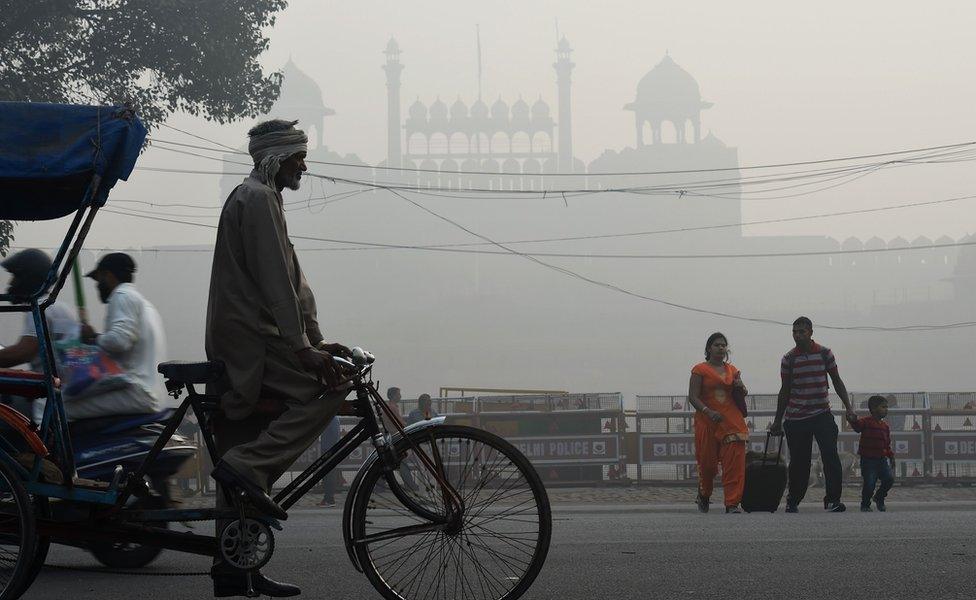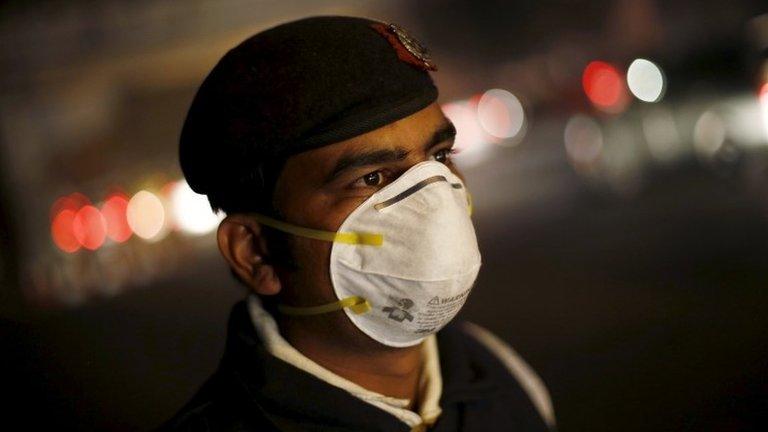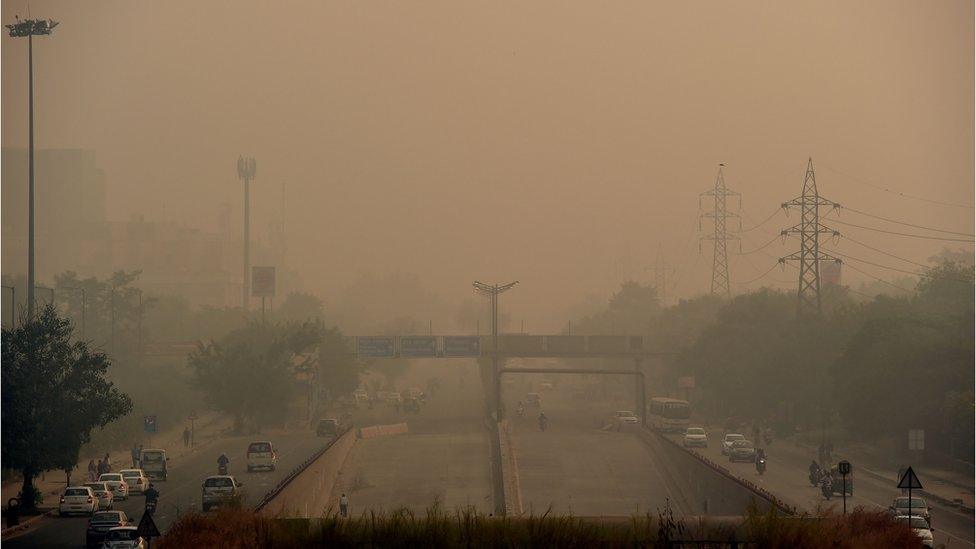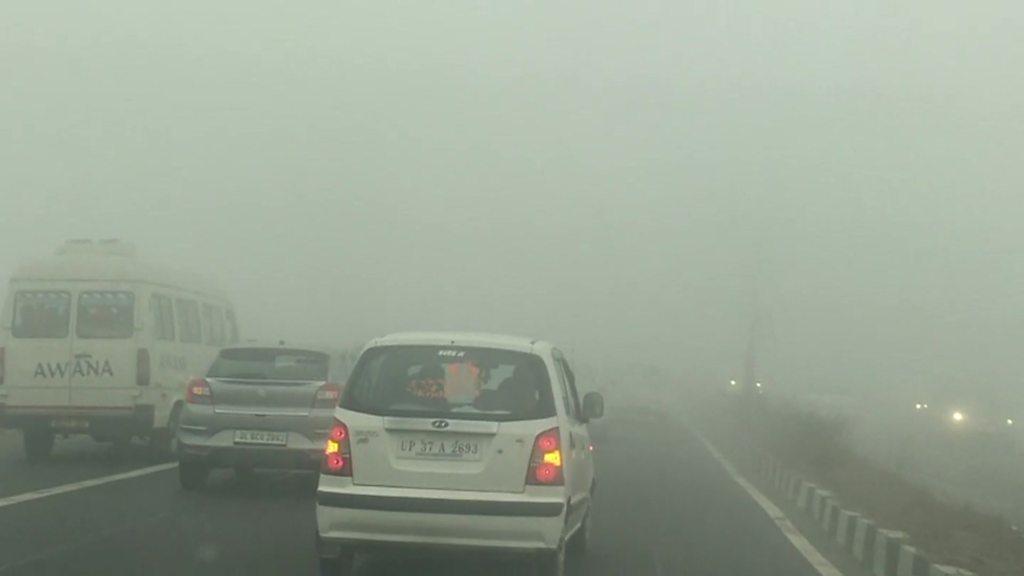Delhi smog: City's residents frustrated over car rationing
- Published

Pollution levels in Delhi have reached 30 times the recommended limit in some areas
Twitter users in the smog-choked Indian capital Delhi have criticised the re-introduction of car rationing as a "tokenistic" effort to curb pollution.
Under the "odd-even" scheme, private cars with even and odd number plates will only be allowed on the roads on alternate days from 13 to 17 November.
Experts say that two previous periods of car rationing reduced traffic but had little impact on pollution.
India's environmental watchdog described the plan as "a farce".
The National Green Tribunal has called on the Delhi government to demonstrate that previous use of the scheme had actually improved air quality.
Delhi's air, among the world's dirtiest, worsens in the winter months.
This happens because farmers in neighbouring Punjab and Haryana states burn crop stubble to clear their fields.
Low wind speeds, dust from construction sites, rubbish burning in the capital and firecrackers used in festivals all contribute to increased pollution levels.
Why then, some of the city's residents asked on Twitter, did authorities wait until the onset of winter this year to pass legislation on car rationing?
Delhi chief minister Arvind Kejriwal, who strongly supports the scheme and has called the city a "gas chamber", drew personal flak for relying on emergency measures to clean up the city's air instead of implementing longer-term solutions.
Allow X content?
This article contains content provided by X. We ask for your permission before anything is loaded, as they may be using cookies and other technologies. You may want to read X’s cookie policy, external and privacy policy, external before accepting. To view this content choose ‘accept and continue’.
"Tokenism" was a word used repeatedly to refer to the measure.
Allow X content?
This article contains content provided by X. We ask for your permission before anything is loaded, as they may be using cookies and other technologies. You may want to read X’s cookie policy, external and privacy policy, external before accepting. To view this content choose ‘accept and continue’.
But some people welcomed the move too.
Allow X content?
This article contains content provided by X. We ask for your permission before anything is loaded, as they may be using cookies and other technologies. You may want to read X’s cookie policy, external and privacy policy, external before accepting. To view this content choose ‘accept and continue’.
Allow X content?
This article contains content provided by X. We ask for your permission before anything is loaded, as they may be using cookies and other technologies. You may want to read X’s cookie policy, external and privacy policy, external before accepting. To view this content choose ‘accept and continue’.
Overall, however, there was a sense of frustration that little is perceived to have been done by the government to improve air quality.
Allow X content?
This article contains content provided by X. We ask for your permission before anything is loaded, as they may be using cookies and other technologies. You may want to read X’s cookie policy, external and privacy policy, external before accepting. To view this content choose ‘accept and continue’.
Nikhil Pahwa, an activist and journalist who has written about air pollution, outlined 22 different ideas on Twitter to curb it, adding that the government has long been aware of such measures.
Allow X content?
This article contains content provided by X. We ask for your permission before anything is loaded, as they may be using cookies and other technologies. You may want to read X’s cookie policy, external and privacy policy, external before accepting. To view this content choose ‘accept and continue’.
Delhi is not the only Indian city with toxic air. Large parts of northern India are also affected - in fact the air in some cities is worse than in Delhi, external.
Reports say that the air in Lahore, Pakistan's second-largest city, is equally thick with smoke and particulate matter, external - tiny pollutants that can lodge inside the lungs and enter the bloodstream.
The Delhi government has also temporarily banned construction work in a bid to improve conditions, and has increased parking fees to discourage people from driving their cars.
A day before the government's announcement, pollution levels in the city had reached 30 times the World Health Organization's recommended limit in some areas.

What are PM2.5 particles?
Fine particulate matter, or PM,2.5, is a type of air pollutant made up of fine particles less than 2.5 micrometres (0.0025mm) in diameter
A second type of particulate matter, PM10, is made up of larger particles with a diameter of up to 10 micrometres.
Some occur naturally - for example, from dust storms and forest fires - while others are produced by industrial processes
They often consist of particles that are small enough to reach into the lungs and, in some cases, cross into the bloodstream as well
A build-up of PM2.5 in the lungs has been associated with respiratory illnesses and lung damage
- Published31 December 2015

- Published3 November 2016

- Published8 November 2017
